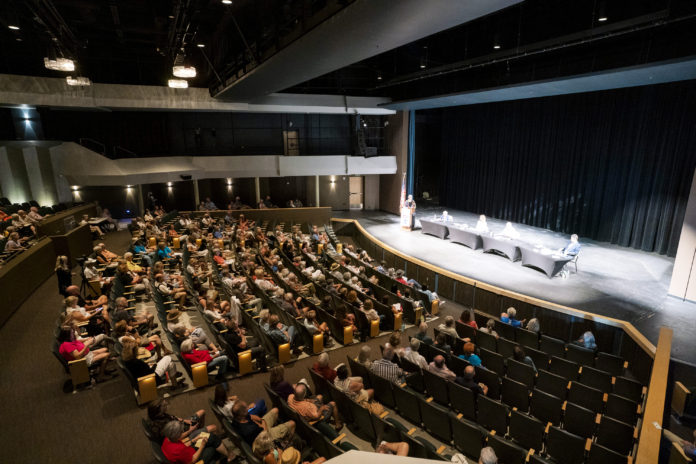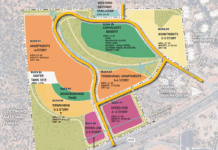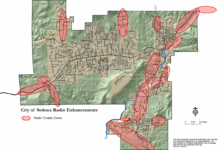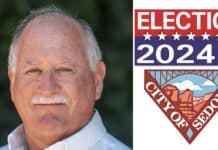
Around 300 residents gathered in the Sedona Performing Arts Center to listen to the city’s four mayoral candidates on Wednesday, July 6.
After the Keep Sedona Beautiful and Northern Arizona Climate Change Alliance environmental forum the evening before, the League of Women Vo t e r s o f N o r t h e r n Arizona focused their questions for the candidates on issues particularly involving some of the city’s main issues, traffic, housing and tourism.
One out of the two questions prepared by LWVNAZ asked about the city’s relationship to tourism currently and in the future.
“We need to have an eye for our residents. We need to have an understanding from our residents and businesses alike for a workable experience,” Vice Mayor Scott Jablow said. “The intent is to have a committee composed of residents, business owners and hotels working together for as long as a year to come up with a plan of either having the city absorb the workload or perhaps a stand-alone group not affiliated with the [Sedona] Chamber of Commerce.
“Right now the system isn’t working because businesses and residents aren’t understanding each other’s concerns.”
“We all need to take a good look at our city and start reevaluating what we need to do as a community,” candidate Kurt Gehlbach said. “One of those is to rewrite the chamber’s responsibilities and get them back on track as every other chamber of the nation. But I would also like to use them to help support us, to help guide tourism around the city.
“Every model that I’m designing for the city works in unison together. And it also works to eliminate all these [short-term rentals].”
“There is no question that tourism is the primary economic engine in Sedona. We continue to work on diversifying the economy, but it is unlikely that there will ever be a time when tourism takes a backseat to anything else,” incumbent Mayor Sandy Moriarty said. “I believe that our relationship with the chamber is an important one and we have committed to examining it over the next year to consider what it should be going forward.
“I don’t believe that, as some have stated, the legal separation of the Chamber of Commerce and the Tourism Bureau in the coming fiscal year is essential. And I don’t think defunding the chamber entirely is reasonable.”
“Our quality of life is not totally dependent on visitors. In fact, unmanaged visitation can be a detriment to our quality of life,” candidate Samaire Armstrong said. “I, for one, say I would like to preserve and nurture our community and the integrity of Sedona …. While some of us can enjoy the relief of the slower pace of Sedona, right now hotels and businesses need immediate action to create a consistent flow of balance and quality visitors.
“As mayor, I will bring all the owners and operators of our local businesses together to hear from them and find out how they feel. The bed tax should be best used for their needs.”
The questions from the audience focused more on the candidate’s specific solutions for the issues of housing, managing issues with Northern Arizona Healthcare including the potential closure of Sedona’ emergency room, water shortages and more.
Armstrong and Gehlbach, while approaching the issues differently, both said they believe that major changes need to take place within the city, specifically, with the lack of affordable housing that many associates with the extreme rise of tourism.
“I am entirely against expanding the density. I’m opposed to four-story complexes that have been voted in by this council that is completely out of sync with the ethos of Sedona,” Armstrong said. “However within 30 miles, we could certainly come up with creative solutions. The No. 1 issue that local businesses are having right now is their employee’s lack of housing …. Until we find housing for these people, why not set up something temporary and safe for them, perhaps like a campground?”
“For some reason, they all got in their head that condensed development was the answer to our short-term rental issue and it’s not,” Gehlbach said. “Then they started getting to these [ideas of] ‘Let’s go three stories. Let’s go four stories ….’ Any plan that I’m seeing is going to work which is the reason why I’m creating a resident participatory program for all of us to get involved because you all have brilliant minds. We need to tackle this together. We do need the workforce housing yet we need to bring this workforce housing into Sedona and literally blend it in with our chosen way of life.”
While Moriarty and Jablow, who were both first elected to council in 2014, defended the city and city staff’s ability to find solutions like their current ventures at Sunset Lofts and other areas around the city.
“The city is working for workforce housing. We have two plans in progress,” Jablow said. “Sunset Lofts, a 46-unit complex, is being built for workforce housing. We don’t own it. We’re just paying into it. It’s going to give reduced rents to the employees they produce [documents] that they work in our city …. Next to City Hall is another piece of property that we’re planning for 22 additional units. But that’s not anywhere near what we need. We need close to 1,500 units. If we actually want enough rentals, we’re landlocked. We’re not going to be able to do that, but we’re doing what we can.”
“Trying to find space for workforce housing in Sedona isn’t easy,” Moriarty said. “As [Jablow] said, Sunset Lofts is that type of a project and because we only have a 4% housing stock in apartments in Sedona …. We do need to have more apartments in Sedona and multiple-family housing. There are some areas we could do it. I’m not totally against a four-story building in the right setting and there are opportunities like that in Sedona already zoned.”
The LWVNZ recorded and uploaded the entire forum onto their website for residents who could not attend.




















